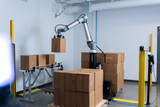Using Machine Vision to Meet New Pharma Compliance Rules
In November of 2023, all pharmaceutical companies will be
required to be compliant with the final legal requirements of the
U.S. Drug Supply Chain Security Act (DSCSA).
The new compliance rules are the final chapter of a decade-long shift toward improved pharmaceutical tracking and traceability, which the U.S. Food and Drug Administration has championed as a way to protect pharma companies and their customers from counterfeit, stolen, contaminated or otherwise harmful drugs.
Pharmaceutical industry players will need to have systems in place to ensure compliance by November, and they’ll need to collect and track clean and accurate aggregation data for each shipment and its physical movement as it travels through the supply chain. Each pharmaceutical must be serialized according to the GS1 standard, so it’s clear which serialized product is in which carton and which carton is in each case and on every pallet. Each product’s physical movement must also be tracked, and all resulting aggregation data must accompany each shipment between trading partners.
It's a big undertaking, and it’s not as simple as adding some barcode labels to products and scanning those labels to track shipments. Compliance will require more detailed, sophisticated and accurate tracking; violators face potentially stiff fines for non-compliance.
However, the good news is that there’s some sophisticated and affordable tracking technology that simplifies the process for pharmaceutical players, and it’s already proven in many current pharma traceability, production, packaging and quality processes.
How Machine Vision Simplifies and Enables Accurate Pharmaceutical Traceability
One of the key technologies for enabling DSCSA compliance will be machine vision, which uses sensors to automatically scan and inspect barcodes, product labels and packaging for billions of pharmaceutical products every year. Machine vision technology uses advanced sensors and cameras to automatically scan and read GS1 barcodes, recognize text characters, and capture hi-res images, which are then instantly analyzed to identify each product, verify its authenticity, document its status or location, and even inspect it to ensure quality.
The resulting data can be sent to production, quality, inventory management or other systems to create a digital record of each product and its movement for DSCSA compliance, and it can be used to automate production processes such as counting, routing or sorting, or inspection processes such as date or lot code checks, label checks, and more.
Zebra Technologies is one of the world’s leading producers of machine vision solutions, including fixed industrial scanners and machine vision sensors that can be installed on high-speed production and packaging lines as well as in warehouses and shipping areas. Its devices are compact, lightweight, and relatively easy to set up and configure using Zebra’s Aurora Focus software. The devices are also engineered to connect to industrial networks and to business systems using all standard communication protocols, allowing virtually any tracking and visual inspection process to be completely automated and all resulting traceability and inspection data to be transmitted securely to back-end systems and documented with digital records.
Pharma companies have already been using Zebra’s machine vision technologies in several production, packaging and distribution processes, and our team at Automation Distribution has worked with Zebra over the past two years to design, deploy and integrate these systems. In many cases, the right data and information is already being collected and tracked to ensure DSCSA compliance, or only a few minor tweaks or updates will be required to ensure that the aggregated data is documented per the FDA’s requirements.
Even if you’re new to machine vision traceability or visual inspection, getting a system up and running is easily feasible and attainable in time for the final DSCSA compliance rules this November. Since Zebra’s machine vision platform is designed for plug-and-play simplicity, is easy to use, and is easily configured using sliders and buttons in Zebra’s software, it’s relatively quick to get a solution up and running. Zebra’s technologies are designed for both beginners and experts, so it’s a short learning curve, and Zebra’s software comes with built-in videos and walkthroughs that guide you through the entire process.
Industrial automation experts at Automation Distribution are also available to help with any part of the process, and we can even design, validate, install and integrate a system for you. As automation and data capture experts since 1977, we offer a full range of solutions, services, training and support to help you deploy a DSCSA tracking system and ensure that it delivers the exact results you need.
Exploring Zebra Machine Vision Solutions for DSCSA Compliance
To learn more about Zebra’s machine vision technologies, including use cases and how these devices can help you ensure DSCSA compliance, Then, if you have any questions or want to explore these solutions further, set up a 15 minute exploratory call. We’d be happy to answer your questions or set up a discovery call at your convenience.
Recent Posts
-
The Impact of AI-Powered Collaborative Robots on Efficiency and Innovation
In the rapidly evolving landscape of industrial automation, collaborative robots, or cobots, are eme …Jul 25th 2024 -
Multinational Pharma Extends Use of Robotiq Palletizing Units
The journey toward improving palletizing efficiencies with one of the world's largest pharmaceutical …Jul 18th 2024 -
Optimize Track and Trace with High-Volume Scanning Solutions
Driving Performance. Leading Solutions. In modern work environments where goals shift rapidly a …Jul 11th 2024




